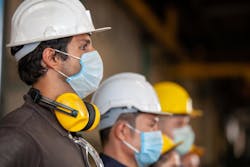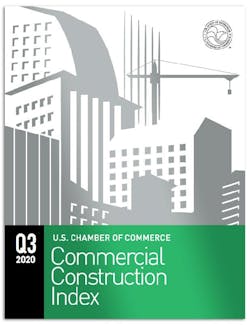U.S. Chamber Third Quarter Index Trends Up
PRESS RELEASE
By THADDEUS SWANEK, Senior Writer, U.S. Chamber of Commerce
(Washington D.C., September 17, 2020) -- The Q3 2020 U.S. Chamber of Commerce Commercial Construction Index, released today, remained fairly steady this quarter, but shows signs of rebound for the industry. This comes after a significant drop in the index last quarter revealing the impact of the COVID-19 shutdowns on the commercial construction industry.
This quarter, although sentiment remains significantly lower than in Q1, two of the three underlying indicators—confidence in new business, and revenue—are up, indicating grounds for cautious optimism about the sector’s future.
The overall index increased by just one point to 57 in Q3, indicating the index is statistically unchanged. Confidence in new business rose six points to 56 in Q3 from 50 in Q2, and revenue expectations increased four points to 48 in Q3 from 44 in Q2. However, those increases were offset by a decline in current backlog, which dropped five points from 73 in Q2 to 68 in Q3.
“The loss of new projects and revenue has been severe for the commercial construction industry, but we may be turning the corner. Contractors’ more positive outlooks on new business and revenue suggest the construction industry is part of a broader economic recovery post-COVID, although industries including travel, entertainment, and hospitality continue to struggle,” said U.S. Chamber of Commerce Executive Vice President and Chief Policy Officer Neil Bradley.
As contractors work through backlog and begin to express optimism for the future, many of the longer-term prospects of the industry will depend on people having growing confidence to return in similar numbers to retail stores, restaurants, and other businesses, as they did pre-COVID.
But depending on where you sit in the COVID economy, business for those industries could be booming or on the brink of bankruptcy. In a recent blog post, U.S. Chamber President Suzanne Clark describes a K-shaped recovery where sectors like technology and retail are in recovery, while services and travel continue to struggle.
Several other findings in the Q3 Commercial Construction Index point to a guarded optimism as contractors head into the last quarter of the year:
Contractors see sufficient work for the coming year. Most (82%) contractors have moderate to high confidence that the U.S. market will provide sufficient new business opportunities in the next 12 months (up seven points from 75% in Q2).
Most expect their revenues to stay the same or increase. The majority (60%) of contractors expect their revenues to remain about the same in the next 12 months (the same as in Q2), and 22% expect an increase. Less (19%) expect a decrease, a slight decline from 21% in Q2.
Most expect to keep same size staff. One in three contractors (32%) plan to hire in the next six months, the same as in Q2. More than half (57%) expect to keep the same number of workers, but only 7% expect to reduce staffing, down from 15% in Q2.
Contractors see diminishing delays due to COVID. Nearly all (85%) contractors are still experiencing delays due to the coronavirus outbreak. However, the average amount of delays has decreased sharply as the year continues: In July, contractors reported an average share of 26% of their projects as delayed, down from 40% in April.
Other key industry findings include:
- Concern over fluctuating costs for materials remains high. Most (62%) contractors indicated that cost fluctuations have a high or moderate impact on their business, up from 59% in Q2.
- Lumber is highest reported shortage. Over half (54%) of contractors report facing shortages for at least one material (up from 45% in Q2). Wood and/or lumber is the most reported shortage at 11%, up from 5% last quarter.
- Contractors are taking action to ensure employees are safe. Nearly all contractors (97%) report making changes in response to COVID-19 this quarter including providing items to protect employee health, such as masks and sanitizer (82%); changing work procedures to increase social distancing (75%); and allowing remote work for office employees (67%).
For the full findings, methodology, and graphics visit www.commercialconstructionindex.com.
About the Commercial Construction Index
The Index is comprised of three leading indicators to gauge confidence in the commercial construction industry, generating a composite Index on the scale of 0 to 100 that serves as an indicator of health of the contractor segment on a quarterly basis. The survey was in the field July 13-20, 2020.
The Q3 2020 results from the three key drivers were:
- Backlog: The backlog indicator dropped to 68 (down five points from 73 in Q2).
- New Business Confidence: The overall level of contractor confidence increased to 56 (up six points from Q2).
- Revenue: Contractors’ revenue expectations over the next 12 months increased to 48 (up 4 points from Q2).
The research was developed with Dodge Data & Analytics (DD&A) by surveying commercial and institutional contractors.
#########

